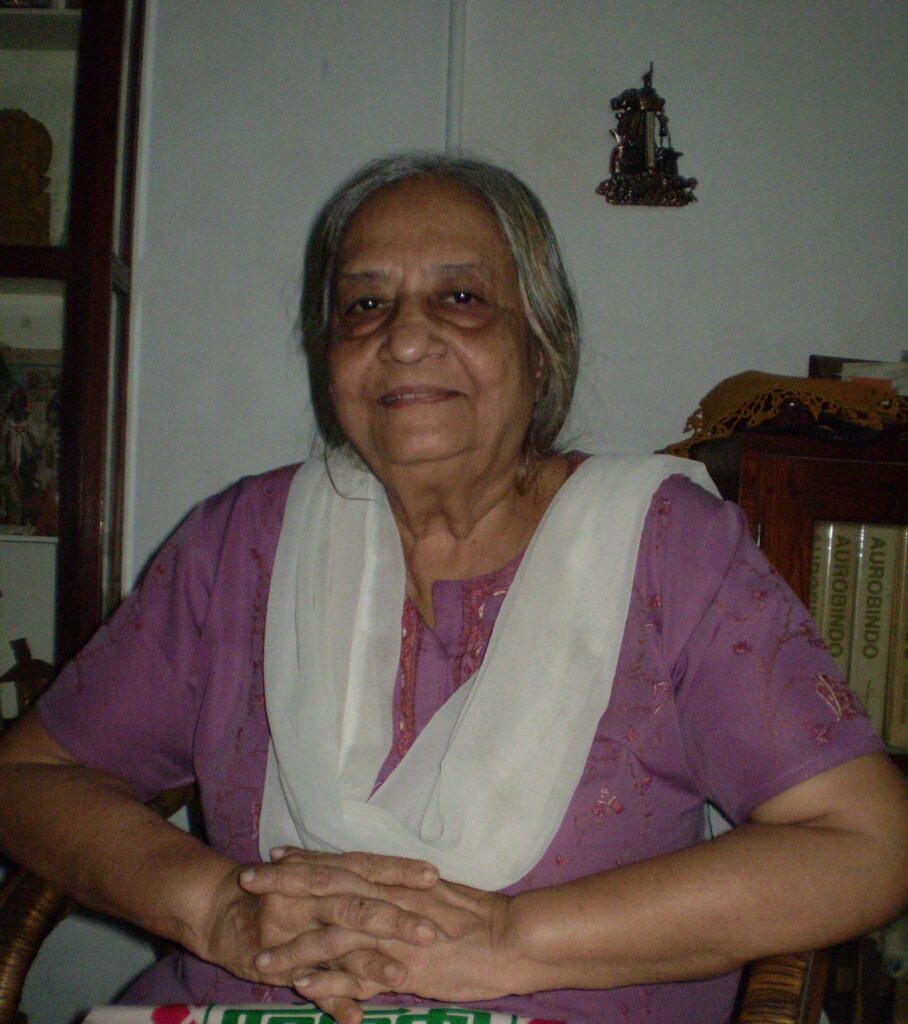
Dear Friends,
She was one of those rare souls who was feared and loved: feared for her courageous personality, straightforwardness and uncompromising attitude and loved for her sincerity, honesty and integrity. Her personality appeared to be rough to some but behind the external garb of roughness there was a tender and sensitive heart and a childlike nature. And those who could reach out to this little-known side to her personality could not help but love her unconditionally. Such was Krishna Chakravarti of Sri Aurobindo Ashram, Pondicherry.
Born in the district of Howrah in West Bengal on 7 December 1943, Krishna was the second daughter of Justice Santosh Kumar Chakravarti and Bokul Rani. Having received her early education in Mahakali Balika Vidyalaya, she visited Sri Aurobindo Ashram at Pondicherry in October 1956 with her parents and siblings (elder sister Ratna, younger sister Rina and brother Subir) during her vacations. All the three sisters developed an instant liking for the Ashram and decided to stay back. Justice Chakravarti returned to Kolkata with his wife and son after putting his three daughters in the Boarding run by a sadhika named Rajkumari with the Mother’s permission. Krishna and her two sisters joined Sri Aurobindo International Centre of Education (then known as Sri Aurobindo International University Centre) and were admitted to lower classes to pick up English and French. In 1957, Bokul Rani and Subir were accepted by the Mother as inmates. Justice Chakravarti joined the Ashram as an inmate in 1972 after his retirement from the judicial service.
To the present author, Krishna had recounted that one of the factors which got her attracted to Sri Aurobindo International Centre of Education was its system of having no examinations. But such was the irony that in 1959 when Krishna was in Class VI, quarterly tests were introduced and that too from Class VI onwards. One had to appear for a three-hour long test for each subject and there was no holiday in between to prepare for the tests. The New System was introduced from the class a year junior to Krishna’s batch and under this system no tests were held. In an article written by her on the Ashram School, Krishna has recounted:
‘Our class went through all these tests till the end of the Higher Course. All of eight years of agony and ecstasy. The last exam was for philosophy and we crossed the educational field uttering the philosophical expression, “liberated souls”, passing out. That was 1966. The tests stopped after 1967. To think of it now, that training of retaining the concentration for three hours, was indeed a necessary part, a preparation for the work given by the Mother later. A most desirable and indispensable training.’ (A Garland of Adoration, p. 98)
To give the students of Sri Aurobindo International Centre of Education an opportunity to participate in extra-curricular activities like drama, dance-recitals, speeches, etc., the ‘Saturday Programme’ was started by Amita Sen. Krishna took an active part in such activities and performed in a playlet which was staged before the Mother on 21 February 1962.
About her schooldays, Krishna has shared two beautiful reminiscences:
‘Our school had a very unique feature in those early years. TRUST. Every month a peon would visit all the classes carrying a tray full of items — like pens, pencils etc. lost by students during the previous month. The tray would be shown to each student and if one happened to locate one’s lost item, one simply picked it up from the tray. The peon then would carry the tray to other students. What a beautiful way to teach us honesty and integrity!’ (A Garland of Adoration, p. 99)
‘Though pampered we were, we had our share of our scolding too. Once, some students of a class got together and wrote to the Mother asking for a Maths teacher of their choice for the next year’s class, instead of the regular strict teacher. The new session started and the Maths class was taken by the strict teacher. A few days later the Mother informed the students through Pavitra-da that if they wanted to continue studying Maths, it would have to be with the regular teacher, otherwise they could leave the subject. And she passed on the letter written by the students to that very teacher! It taught us that OBEDIENCE is another KEY to this place. Years later we realised how important it was to have a teacher who kept us under strict discipline. We learnt that strictness is not a punishment but a blessing.’ (Ibid., p. 100)
Having completed her education in 1966, Krishna was selected by the Mother to work in the Central Office of the Ashram. From 1966 to 1969, she worked under K. Amrita, the Manager of the Ashram, at the Central Office. Even at that early age, she had earned the reputation of being a diligent worker. The Mother had once remarked to Amrita about Krishna: “Before I tell her anything, she does it. She knows what she has to do without my telling her.” Krishna also worked for a few months with Satyakarma, the Cashier of the Ashram (about whom the Mother had remarked after his demise: “I trusted him very much.”) when the latter’s assistant Mani-bhai was ill. When the responsibility of the Central Office fell on Dyuman following the demise of Amrita in January 1969, Krishna worked with him until his demise in August 1992. Eventually, she became the In-charge of the Central Office and held this position till the end of her life.
Justice Santosh Kumar Chakravarti wanted to purchase a house for his family in Pondicherry. Although the inmates of the Ashram got a house or an apartment for their accommodation from the Mother, he was not keen to impose this additional burden on the Mother whom he loved and adored like his own biological mother. When a suitable house was purchased, Krishna went to the Mother with Bokul Rani and her siblings on 2 October 1966 to receive a name for the newly acquired property. The Mother gave an envelope containing a signed card on which She had written La Maison, Bénédictions along with the date. When the meaning of the term was explained to Bokul Rani, she asked in Bengali: “Only the house?” Obviously she was not satisfied as other houses had received beautiful names from the Mother. The Mother understood and explained that La Maison meant not just a house but The Home; if asked where one was going, one could reply that he was going Home. And She added in French: “I hope it will be a true home and a beautiful home.” When a pomegranate plant (named ‘Divine Love’ by the Mother) planted in the garden of La Maison began to give flowers, Krishna started to send its flowers to the Mother who would send back a rose for her.
The present author had met Krishna and her eldest sister Ratna for the first time in the evening of 25 November 2008 at the premises of Ramakrishna Mission Institute of Culture situated in Golpark in south Kolkata. Prior to this meeting, Krishna had written two affectionate letters to the author after having read two of his books entitled Achinpather Divyapathik and Debotar Shrom which were sent to her as a gift. This meeting gave birth to a most intimate relationship the warmth of which Time could never diminish.
The author became a regular visitor to Krishna’s residence whenever he visited Pondicherry and would have long chats with her and Ratna who would serve sumptuous meals cooked by her. Krishna would narrate how the Ashram was diligently looked after by stalwarts like Dyuman and P. Counouma after the physical departure of the Mother. “Can you believe there were no court cases till 1993!” she had once remarked while expressing her sadness at the ongoing legal battles the Ashram was involved in at that time. She was always full of praise for Nolini Kanta Gupta, Amrita, Satyakarma and Dyuman and held them in high esteem. ‘Dyuman-bhai used to say, “I am protecting the Ashram with my very flesh!”’ she once recalled. She respected every senior member of the Ashram but adored only the Mother. Once, when asked to cite a concrete instance of the Mother’s grace, she replied: “The very functioning of the Ashram itself is the best example of the Mother’s grace!”
Another aspect of Krishna’s personality was her delightful sense of humour. However, not many were aware of it. She loved to joke, but most importantly, she knew how to laugh, not at others, but at her own self. Once, she showed a photograph of her taken during a cultural programme in which she could be seen seated right before the Mother in the Ashram Playground. She was narrating how she got this photograph. She had gone to attend a pictorial exhibition on the Mother: while looking at the various photographs, when she was about to turn away, one of the framed photographs suddenly fell down from the wall. Krishna promptly picked it up and was about to hand it over to someone standing close by when her eyes fell on the photograph and she was surprised to see herself with the Mother. She never knew that a photograph of her with the Mother existed. She got a copy of this photograph, got it laminated and framed and brought it to her house. This photograph in which she had featured with the Mother was taken when Krishna was quite young. So the present author asked her in which year should he had taken birth to see her in such a ravishing avatar. “1940,” Krishna replied. “Please don’t mind,” the author said, “but by working for long hours in the Central Office, you certainly have become quite unromantic.” “Why do you say so?” she asked back. “If you had to mention a year, why did you say 1940? My grandmother was six years old in 1940!” the author replied. And what a laugh she had! A laugher like hers is rarely found!
As the In-charge of the Central Office, Krishna had to take certain decisions which did not go well with many. At times her decisions were misjudged and misinterpreted which in turn gave rise to unpleasant reactions. Whenever these reactions were reported to her, she would exclaim, “Is it so!” smile dignifiedly and then become silent for a while. Throughout those moments of silence, she would keep a smiling face but her eyes would reveal that she was genuinely hurt. After all, the decisions she took were never for her own personal sake but for the sake of the institution which she was associated with. And she loved the institution more than herself! Once when she came to know that a gesture of her was largely misinterpreted, she said: “But I didn’t mean so!” That was the only occasion when the present author had seen her visibly upset. She criticized people openly for their wrong decisions and actions but at the same time she never hesitated to shower praise on those same persons for the qualities they possessed. She could foresee the repercussions of a certain course of action and would give her opinion. Many times her suggestions were ignored. But when these actions backfired and ruined age-old reputation, people realized how accurate she was in her analysis.
Right from her early age, Krishna was an avid reader and also fond of writing. Despite her hectic schedule at the Central Office, she still managed to write short but beautiful articles in English and Bengali. Her first book — a biography of Sri Aurobindo in Bengali entitled Sri Aurobindo: Loho Pronam — was published in 2005 and was followed by A Garland of Adoration — an anthology of her writings in Bengali and English — in 2007. Another book in Bengali entitled Judge Saheb o Maharanir One Third Dozen-er Kahini — published in 2009 — was a collection of humorous incidents involving her parents and siblings.
When Overman Foundation was established in March 2010, Krishna became its Founder-Member and took an active part in several programmes arranged by the organization in Pondicherry.
With the passage of Time, Krishna’s health began to fail. The demise of her elder sister Ratna — known in the Ashram community for her exquisitely melodious voice — in March 2017 was a setback which she bore with a valiant spirit. A year later, on the occasion of Ratna’s first death anniversary, a collective meditation was held at La Maison in which the present author was present. After the meditation ended, Krishna told him: “A few months before Didi [meaning Ratna] passed away, one day while we were walking towards our house, suddenly I could hear some unearthly voices saying, “Which one to take? This one (pointing to herself)? Or, that one (indicating Ratna)?” Now I realize that they had come to take one of us away to the other world.”
The author met Krishna for the last time in the last week of February 2020 when an informal gathering was arranged at her residence in which he spoke on the ancestors and family members of Sri Aurobindo. Following the outbreak of the Covid-19 pandemic, Krishna had stopped receiving visitors for a long time. That’s why the present author could not meet her during his visit to Pondicherry in August 2021. Of course they were in touch through phonecalls and Whatsapp.
From the middle of 2022 Krishna’s health deteriorated considerably. Her movements had become quite slow and there was a noticeable loss of appetite. In addition to asthma (which she suffered from since her early years) her kidneys started to fail. In July 2022 she was advised by the doctor for immediate hospitalization if she faced any physical discomforts. On 8 August it was observed that she had not passed urine for the past twenty-four hours and she looked visibly weak. Following the insistence of her youngest sister Rina, she agreed to go to Kidney Centre but only after the Darshan of 15th August. But she was admitted to Kidney Centre on 8th August itself and treatment was immediately started. However, the doctor reported that she was already half in coma and that if she had visited the Centre a month earlier, she would have come out of it.
On Saturday, 10 September 2022, Krishna spoke with her sister for the last time although she was on oxygen. Soon after, she suffered a heart attack and slipped into coma. She remained in that state till Tuesday, 13 September when she breathed her last at 11.55 p.m. Interestingly, it was at 11.55 p.m. that she was born seventy-eight years ago.
Krishna Chakravarti was a worker par excellence. Her work at the Central Office was not only her means of inner growth and spiritual progress but it also represented her dedication and devotion to Sri Aurobindo and the Mother. Work was her very breath, her very life! And it was no ordinary work. It was the Mother’s work that she executed for fifty-six years and she derived the joy of faithfulness from it. To conclude in her own words:
‘Let [the] Joy of Faithfulness be forever in my soul and guide me over the years and the lives to come to remain faithful — ever faithful — to the all beatific Divine Mother, to our very near and dear Douce Mère.’ (A Garland of Adoration, p. 68)
With warm regards,
Anurag Banerjee
Founder,
Overman Foundation.
_______
The following birthday cards were given to Krishna Chakravarti by the Mother.
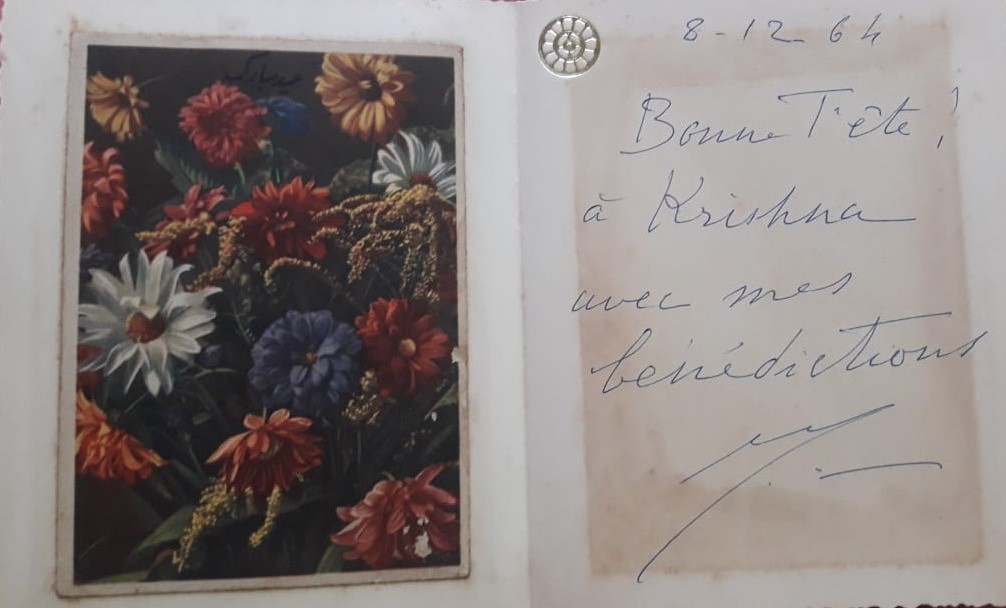
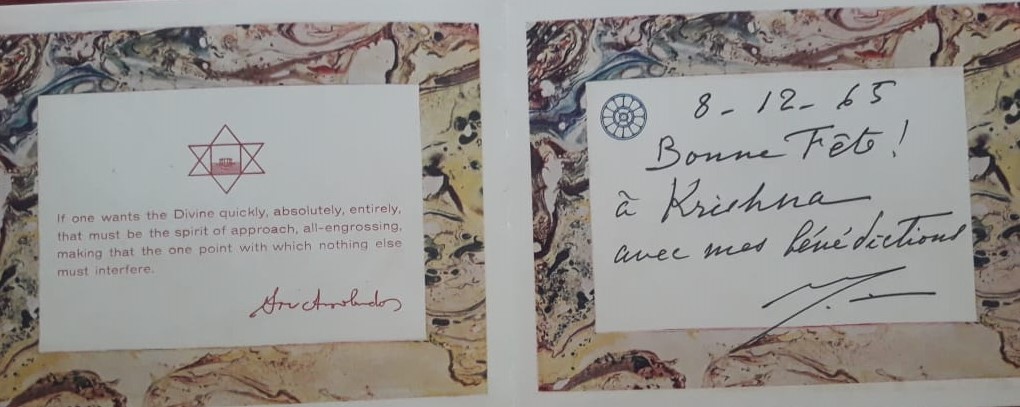

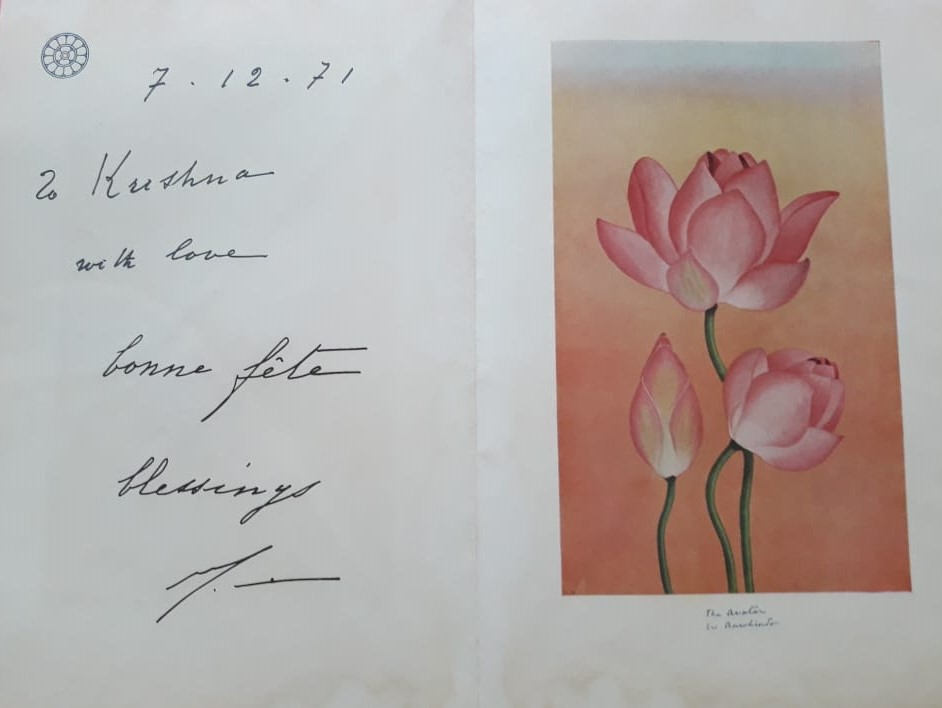
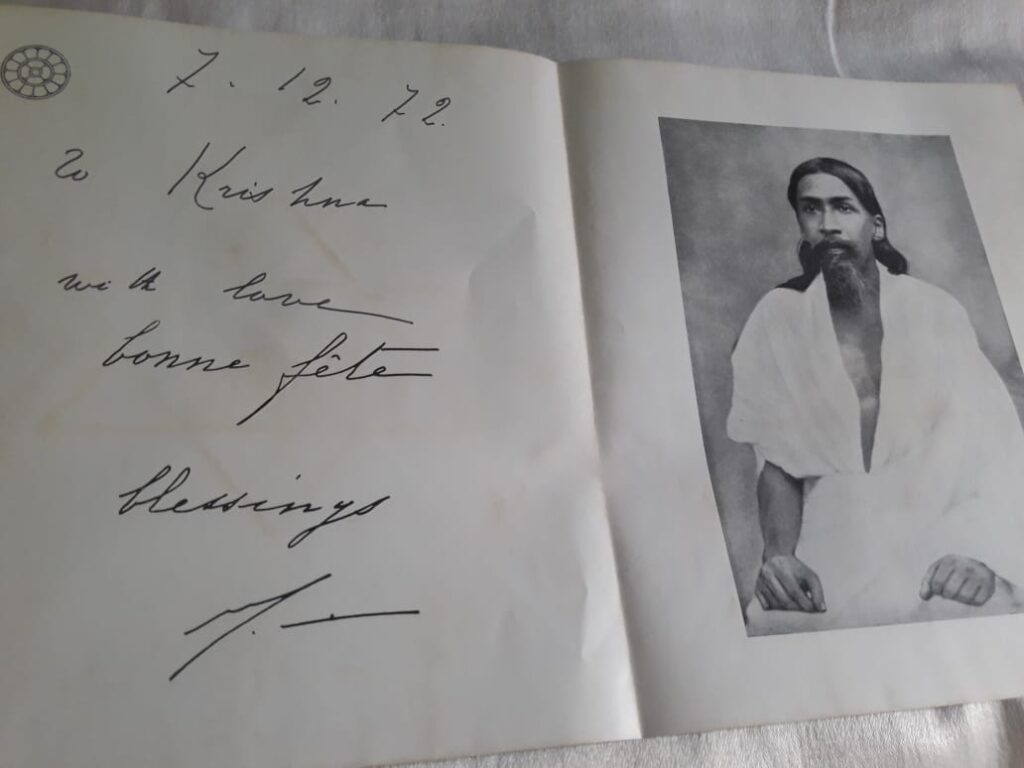
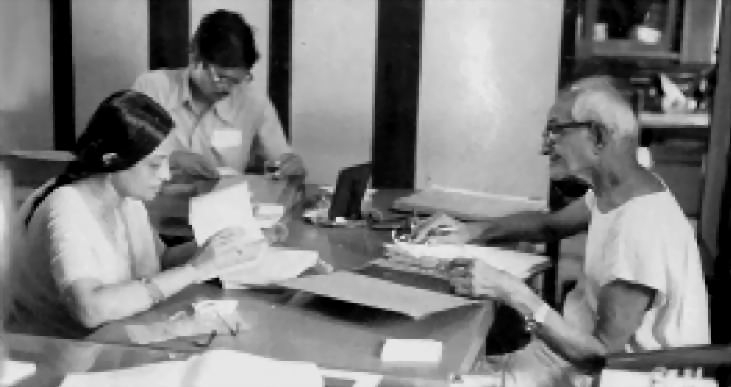
Krishna Chakravarti with Dyuman-bhai.
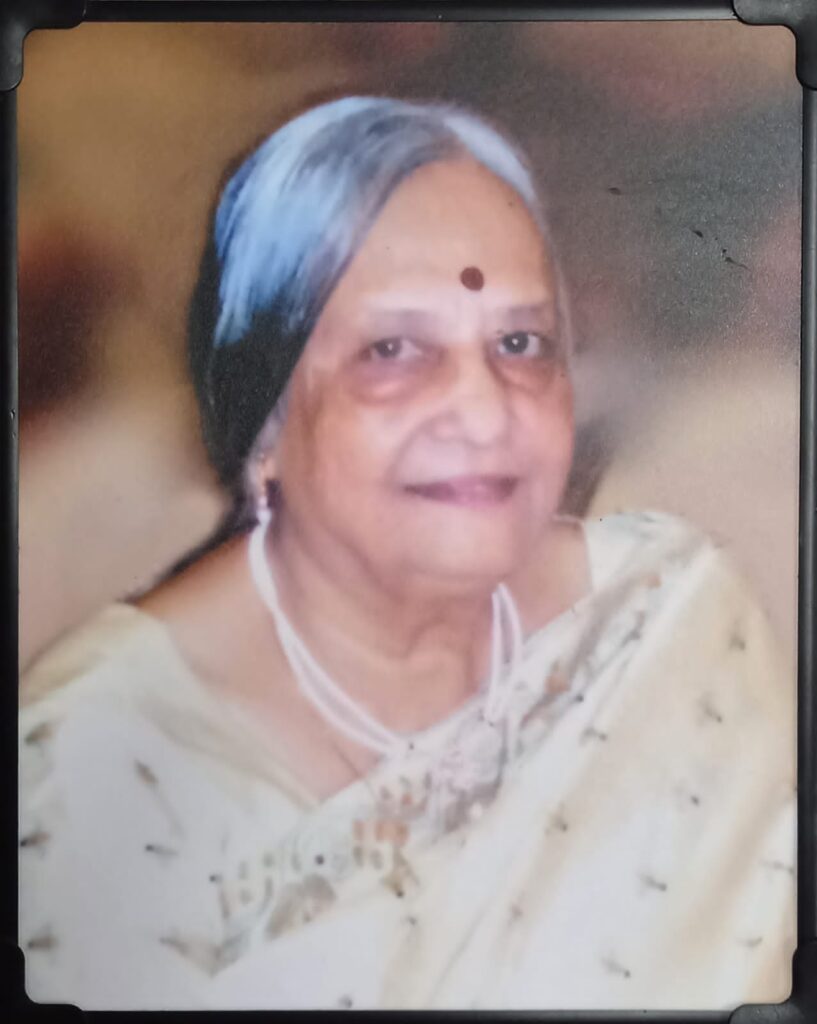
Krishna Chakravarti in November 2008.
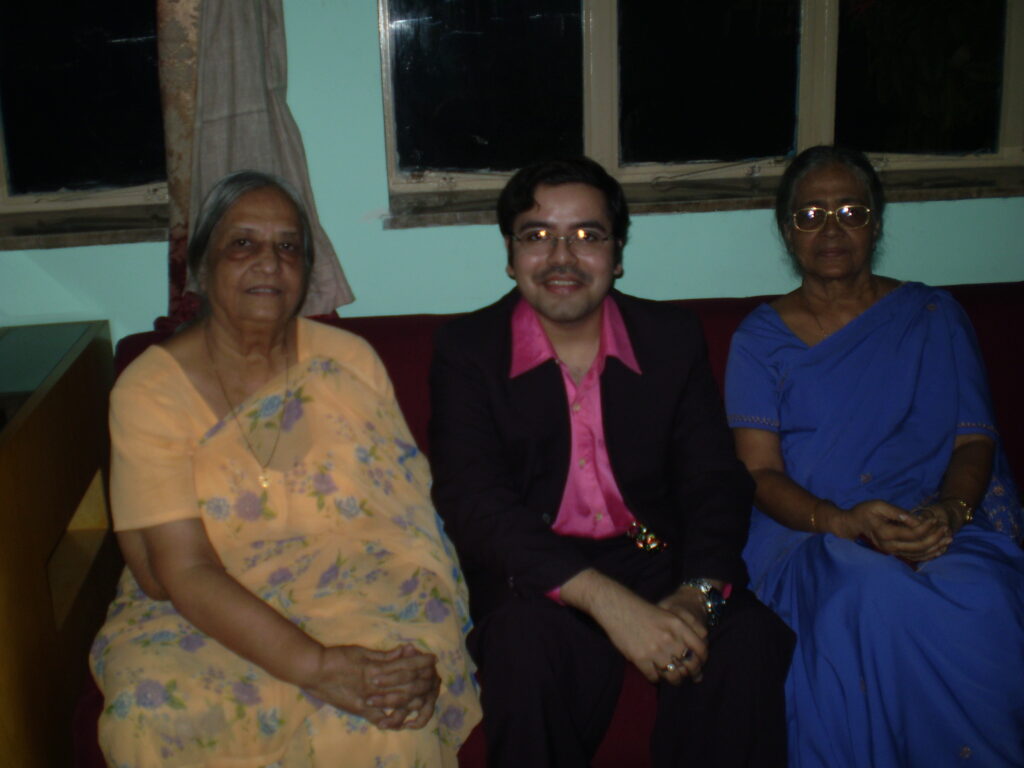
Krishna and Ratna Chakravarti with Anurag Banerjee on 25 November 2008 at Ramakrishna Mission Institute of Culture, Kolkata.
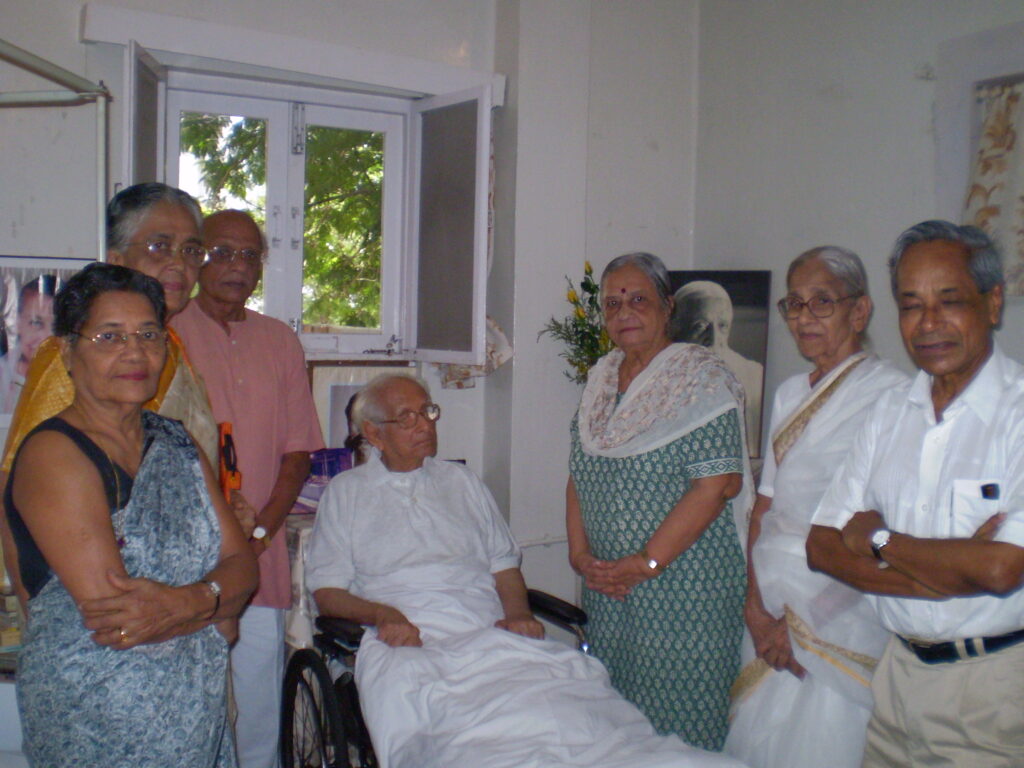
(Left to right: Dolly Mustuddi, Ratna Chakravarti, Kittu Reddy, K.D. Sethna alias Amal Kiran, Krishna Chakravarti, Suprabha Nahar and Dr. Dilip Kumar Dutta)
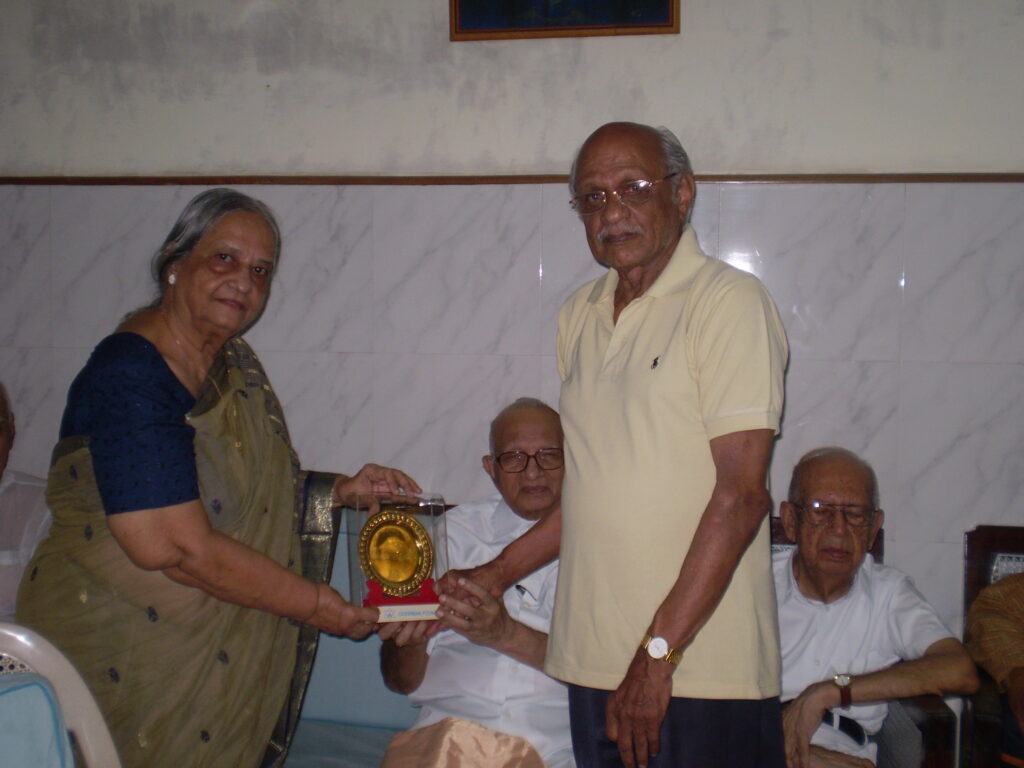
Krishna Chakravarti with Kittu Reddy, Dr. Kireet Joshi and Dr. A. S. Dalal.
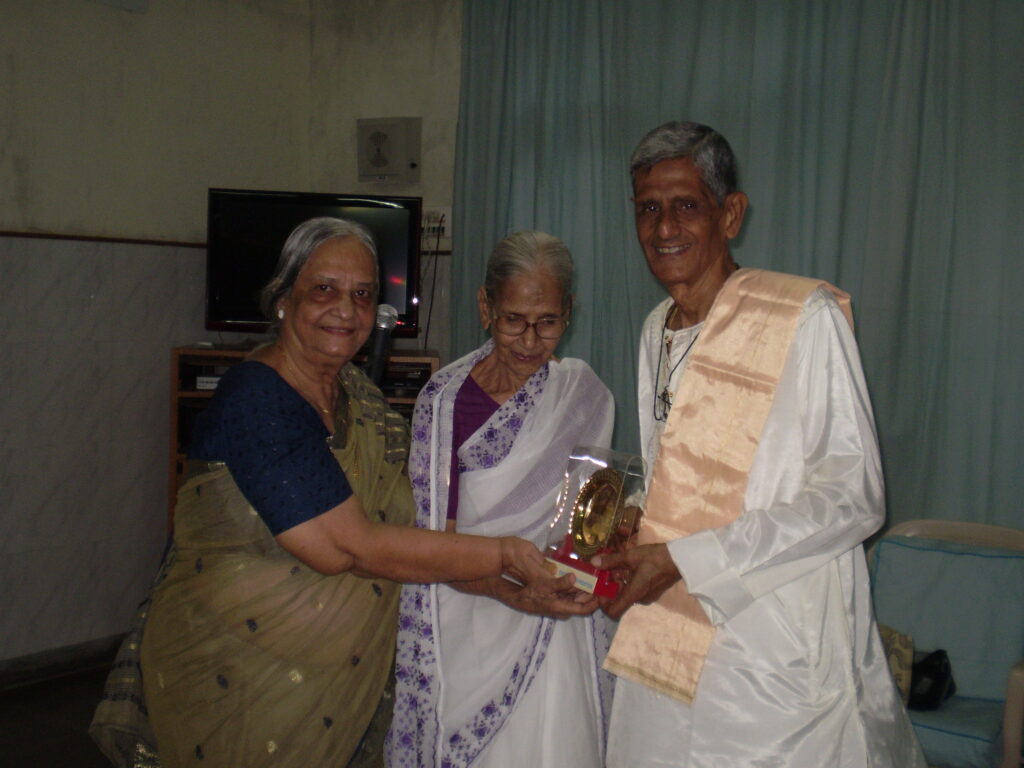
Krishna Chakravarti with Suprabha Nahar and Togo Mukherjee.
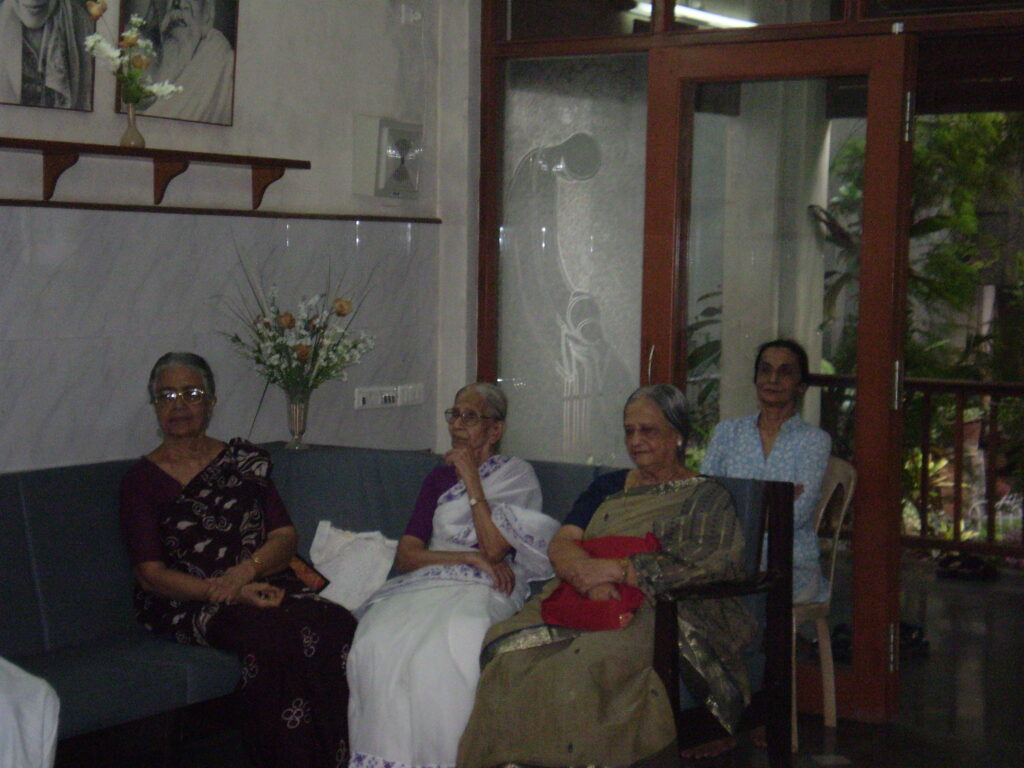
Ratna Chakravarti, Suprabha Nahar, Krishna Chakravarti and Jhumur Bhattacharya.
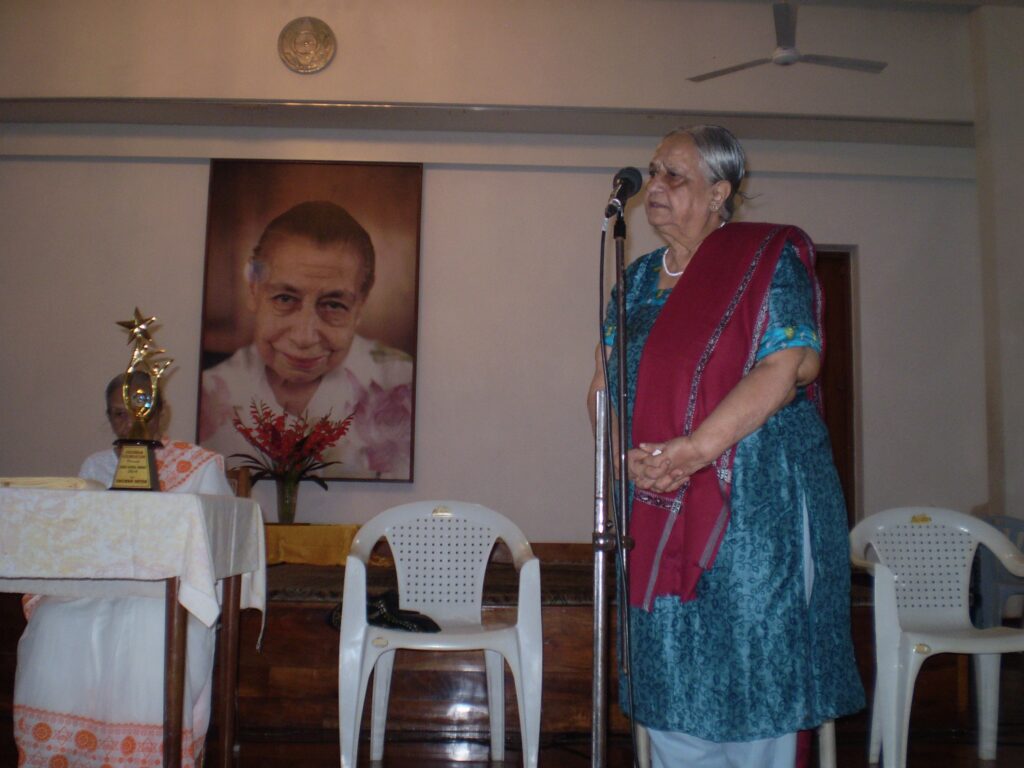
Krishna Chakravarti with Shobha Mitra at the Hall of Harmony, Sri Aurobindo International Centre of Education, Pondicherry.
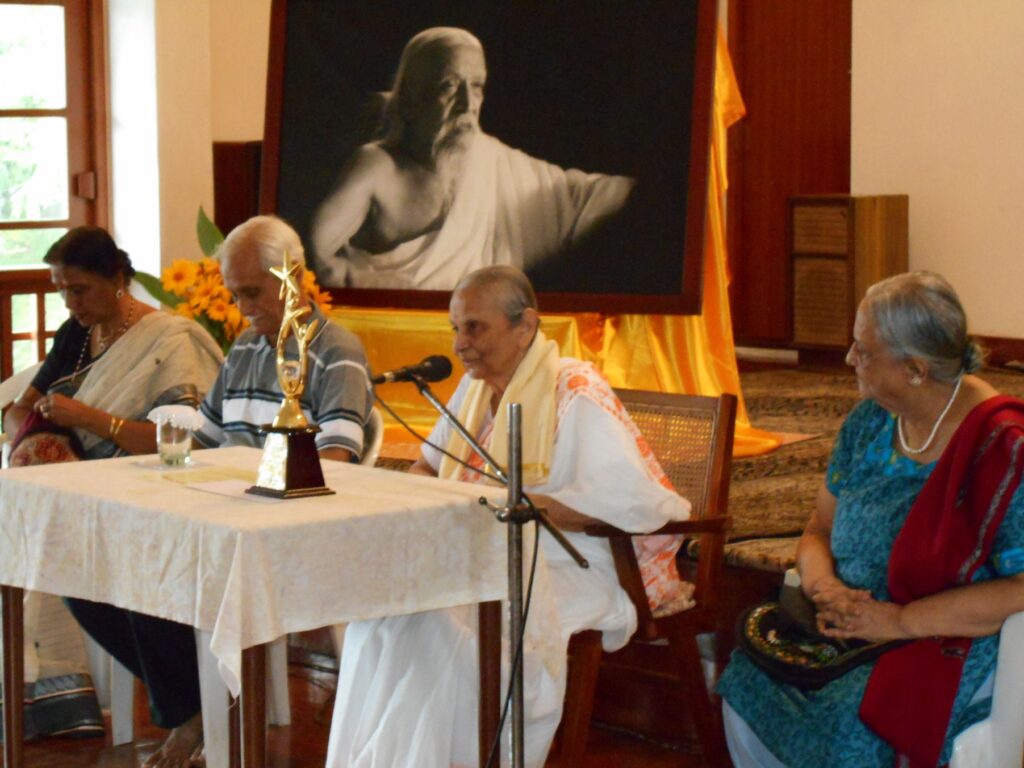
Truly a committed sadhika, who held the fort in spite of all the storms and trials and tribulations. Merci Anurag for the first hand account.